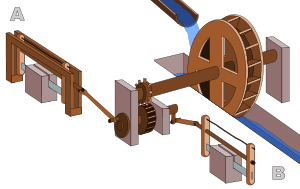Hierapolis sawmill

The Hierapolis sawmill was a Roman water-powered stone sawmill at Hierapolis, Asia Minor (modern-day Turkey). Dating to the second half of the 3rd century AD,[2] the sawmill is the earliest known machine to combine a crank with a connecting rod.[1]
The watermill is evidenced by a raised relief on the sarcophagus of a certain Marcus Aurelius Ammianos, a local miller. On the pediment a waterwheel fed by a mill race is shown powering via a gear train two frame saws cutting rectangular blocks by the way of connecting rods and, through mechanical necessity, cranks (see diagram). The accompanying inscription is in Greek and attributes the mechanism to Ammianos' "skills with wheels".[3]
Other sawmills
Further Roman crank and connecting rod mechanisms, without gear train, are archaeologically attested for the 6th century AD water-powered stone sawmills at Gerasa, Jordan,[4] and Ephesus, Turkey.[5] A fourth sawmill possibly existed at Augusta Raurica, Switzerland, where a metal crankshaft from the 2nd century AD has been excavated.[6]
Literary references to water-powered marble saws in Trier, now Germany, can be found in Ausonius' late 4th century AD poem Mosella. About the same time, they also seem to be indicated by the Christian saint Gregory of Nyssa from Anatolia, demonstrating a diversified use of water-power in many parts of the Roman Empire.[7]
The three finds push back the date of the invention of the crank and connecting rod mechanism by a full millennium;[8] for the first time, all essential components of the much later steam engine were assembled by one technological culture:
With the crank and connecting rod system, all elements for constructing a steam engine (invented in 1712) — Hero's aeolipile (generating steam power), the cylinder and piston (in metal force pumps), non-return valves (in water pumps), gearing (in water mills and clocks) — were known in Roman times.[9]
References
- ↑ 1.0 1.1 Ritti, Grewe & Kessener 2007, p. 161; Grewe 2009, p. 429; Grewe 2010
- ↑ Ritti, Grewe & Kessener 2007, p. 140
- ↑ Ritti, Grewe & Kessener 2007, pp. 139–141
- ↑ Seigne 2002a; Seigne 2002b; Seigne 2002c
- ↑ Mangartz 2010; Ritti, Grewe & Kessener 2007, pp. 149–153
- ↑ Schiöler 2009
- ↑ Wilson 2002, p. 16
- ↑ Ritti, Grewe & Kessener 2007, p. 161
- ↑ Ritti, Grewe & Kessener 2007, p. 156, fn. 74
Sources
- Roman sawmill at Hierapolis
- Ritti, Tullia; Grewe, Klaus; Kessener, Paul (2007), "A Relief of a Water-powered Stone Saw Mill on a Sarcophagus at Hierapolis and its Implications", Journal of Roman Archaeology 20: 138–163
- Grewe, Klaus (2009), "Die Reliefdarstellung einer antiken Steinsägemaschine aus Hierapolis in Phrygien und ihre Bedeutung für die Technikgeschichte. Internationale Konferenz 13.−16. Juni 2007 in Istanbul", in Bachmann, Martin, Bautechnik im antiken und vorantiken Kleinasien, Byzas (in German) 9, Istanbul: Ege Yayınları/Zero Prod. Ltd., pp. 429–454, ISBN 978-975-8072-23-1
- Grewe, Klaus (2010), "La máquina romana de serrar piedras. La representación en bajorrelieve de una sierra de piedras de la antigüedad, en Hierápolis de Frigia y su relevancia para la historia técnica (translation by Miguel Ordóñez)", Las técnicas y las construcciones de la Ingeniería Romana, V Congreso de las Obras Públicas Romanas (in Spanish), pp. 381–401
- Roman sawmill at Gerasa
- Seigne, J. (2002a), "Une scierie mécanique au VIe siècle", Archéologia (in French) 385: 36–37
- Seigne, J. (2002b), "Sixth-Century Waterpowered Sawmill", Journal of the International Society of Molinology 64: 14–16
- Seigne, J. (2002c), "A Sixth Century Water-powered Sawmill at Jerash", Annual of the Department of Antiquities of Jordan 26: 205–213
- Roman sawmill at Ephesos
- Mangartz, Fritz (2010), Die byzantinische Steinsäge von Ephesos. Baubefund, Rekonstruktion, Architekturteile, Monographs of the RGZM (in German) 86, Mainz: Römisch-Germanisches Zentralmuseum, ISBN 978-3-88467-149-8
- Possible Roman sawmill at Augusta Raurica
- Schiöler, Thorkild (2009), "Die Kurbelwelle von Augst und die römische Steinsägemühle", Helvetia Archaeologica (in German) 40 (159/160): 113–124
Further reading
- Seigne, J. (2006), "Water-powered Stone Saws in Late Antiquity. The Precondition for Industrialisation?", in Wiplinger, G., Cura Aquarum in Ephesos. Proceedings of the 12th Int. Congress on the History of Water Management and Hydraulic Engineering in the Mediterranean Region, Ephesus/Selçuk, Turkey, October 2-10, 2004, Vol. 1, Babesch suppl. 12, Leiden: Peeters, pp. 383–390, ISBN 978-90-429-1829-0
- Wikander, Örjan (2000), "Industrial Applications of Water-Power", in Wikander, Örjan, Handbook of Ancient Water Technology, Technology and Change in History 2, Leiden: Brill, pp. 401–412, ISBN 90-04-11123-9
- Wikander, Örjan (2008), "Sources of Energy and Exploitation of Power", in Oleson, John Peter, The Oxford Handbook of Engineering and Technology in the Classical World, New York: Oxford University Press, pp. 136–157, ISBN 978-0-19-518731-1
- Wilson, Andrew (2002), "Machines, Power and the Ancient Economy", The Journal of Roman Studies 92: 1–32, doi:10.2307/3184857, JSTOR 3184857
See also
- List of Roman watermills
- Barbegal aqueduct and mill
External links
![]() Media related to Roman mills at Wikimedia Commons
Media related to Roman mills at Wikimedia Commons
- Traianus – The European Portal of Roman Engineering to download "La máquina de serrar piedras", Klaus Grewe′s article translated into Spanish, one needs to register at the site for free
- Reconstruction of the water-powered sawmill at Ephesos (pictures, videoclips, 3D simulation) (German)